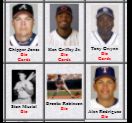1954 Topps #201 Al Kaline ROOKIE [#] AUTOGRAPHED (Tigers)
![1954 Topps #201 Al Kaline ROOKIE [#] AUTOGRAPHED (Tigers) cards value](/jpgs/5/1954-201b.jpg)

Please wander around the website for more info, prices, values & images
on vintage baseball, football, basketball, hockey, sport and non-sports cards.
Carl Yastrzemski Baseball Cards
|



1981 Fleer Baseball
Collector's were excited when they heard Fleer was re-entering the
baseball card market. Their prior issues, the 1959 Fleer Ted Williams
set and their 1963 Fleer baseball-Star sets were hgue succeses.
What did they have up their sleeve ???
Other issues you may be interested in: The answer was NOTHING ! What a mess. Awful ! Poorly printed on medicore card stock, the images were even worse. Then to cap it off, Fleer introduced tons of errors into their set. Some think it was done on purpose to force collector's to keep collecting. Nearly all were useless. The only one to draw much attention was the Graig Nettles variations. One had his name spelled Craig on back. WOW !!!
TOP ROOKIES: Hall-of-Famers Tim Raines and Harold Baines. Oother rookies of note were Danny Ainge, later a pro with the Boston Celtics and World Series hero Kirk Gibson. 1963 Fleer Baseball 1981 Fleer Baseball (You may be on that page now) 1982 Fleer Baseball |

The first baseball trading cards date back to 1869. For many years, baseball cards were packaged in packs of tobacco as a way to increase sales the same way that today prizes are packaged in boxes of cereal. In the 1920's and 1930's, candy and gum companies started packaging baseball cards in their products as well.
Baseball card production was virtually halted in the early 1940's due to paper shortages created by World War II. The "Modern Era" of baseball cards began in 1948 when Bowman Gum Inc. offered one card and one piece of gum in a pack for a penny.
The first important football set was the Mayo set featuring college players in 1984. Other than the 1935 National Chicle set no other key football set was issued until 1948 when noth Bowman and Leaf produced sets.

